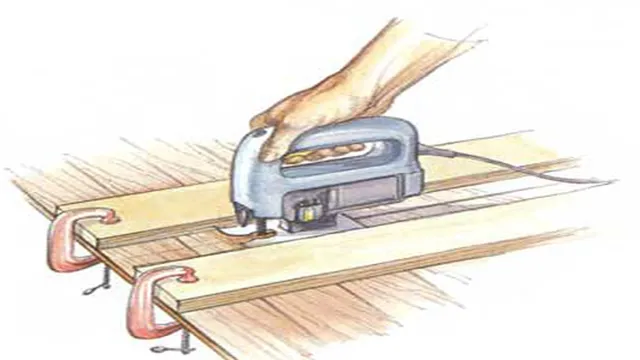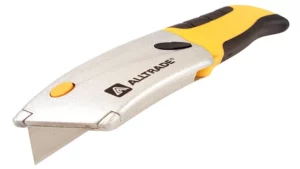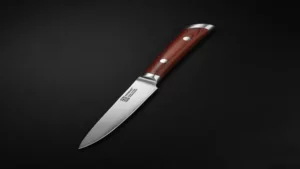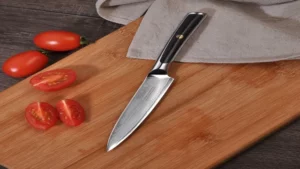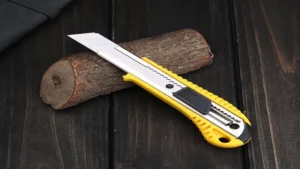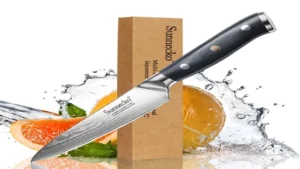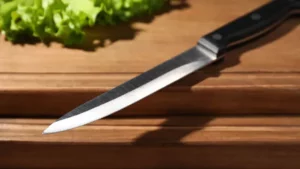Cutting paneling can be a daunting task, but it doesn’t have to be. With the right tools and some helpful tips and tricks, you can cut paneling with ease. One tool that can come in handy for cutting paneling is a utility knife.
Unlike saws, utility knives allow for precision and control, making them a popular choice for DIYers and professionals alike. In this blog post, we’ll take a closer look at how to cut paneling with a utility knife and offer some helpful tips to make the process easier. Whether you’re an experienced DIYer or just starting out, these tips and tricks will help you achieve a clean and professional-looking cut every time.
What is Paneling?
Paneling is a type of wall covering that adds texture and style to any room. It is often made from wood, but can also be made from vinyl or other materials. One of the most common questions people have when working with paneling is whether or not it can be cut with a utility knife.
The answer is yes! In fact, using a utility knife to cut paneling can be easier than using a saw, especially if you are working with thinner materials. Just make sure to use a sharp blade and to score the paneling multiple times before attempting to make the final cut. This will help prevent the paneling from splintering or cracking and will give you a more precise cut.
Whether you are installing paneling in a single room or throughout your entire home, using a utility knife can be a great way to make the process smoother and more efficient.
Definition of Paneling
Paneling is a type of wall or ceiling covering that involves the use of decorative panels or wooden boards to enhance the look of a room. It is a popular interior design feature that has been used for centuries, beginning as a practical solution to cover up rough surfaces and provide insulation before evolving into an aesthetic feature. Paneling can be made from a variety of materials such as wood, PVC, metal, and even fabric, and can be found in a range of different styles, from traditional to contemporary.
It is often used to add texture, warmth, and character to a space, and is an affordable and simple way to update the look of a room without the need for major renovations. Whether you’re looking to create a cozy cabin feel or upgrade a modern space, paneling can be a versatile and stylish addition to any home.
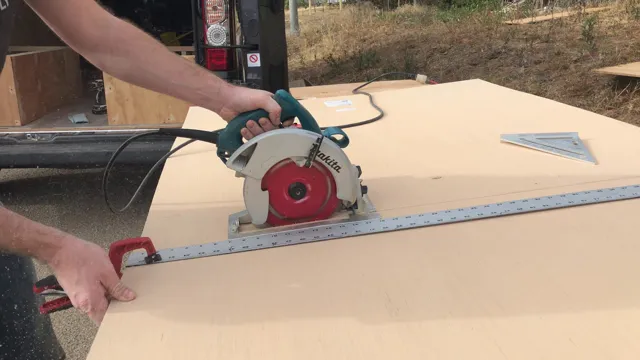
Types of Paneling
Paneling is a popular interior design element that adds charm and character to any space. It involves covering walls, ceilings, or floors with decorative or functional panels made of wood, metal, plastic, or composite materials. There are various types of paneling available, including tongue-and-groove, beadboard, shiplap, raised panel, flat panel, wainscoting, and veneer.
Tongue-and-groove paneling features interlocking boards that fit snugly together, creating a seamless and uniform look. Beadboard paneling has vertical grooves and ridges on its surface, providing a cozy and vintage feel. Shiplap paneling features overlapping boards that create a distinctive shadow line, giving a rustic and inviting feel.
Raised panel, flat panel, and wainscoting paneling offer a more formal and elegant look, perfect for traditional or classic interiors. Veneer paneling mimics the look of real wood, stone, or brick, adding a touch of natural beauty to any space. With so many options to choose from, paneling can help transform any room from bland to beautiful.
How to Cut Paneling with a Utility Knife
When it comes to cutting paneling, a utility knife can definitely do the job. In fact, it can be a great option for those who don’t have access to saws or other power tools. To start, measure the paneling and mark where you need to make the cut.
Then, using a straight edge, score along the marked line with the utility knife, making several light passes until the cut is deep enough. Once you’ve scored along the entire length of the paneling, snap it along the scored line. Depending on the thickness and type of paneling, you may need to make additional cuts to fully separate the pieces.
Just be sure to take your time and steady your hand to ensure straight and precise cuts. So, to answer the question “Can you cut paneling with a utility knife?”- the answer is yes, with some patience and precision, you can definitely cut paneling with a utility knife.
Prepare Your Tools
Cut Paneling with Utility Knife If you’re planning to cut paneling, a utility knife is an excellent choice for the job. You’ll need to prepare the tools required for this process. Make sure you have a fresh blade in your utility knife to get the best results.
Before starting the cut, determine the size of the paneling piece you require to make sure you get an accurate cut. Measure twice and cut once. Ensure that you have a stable working surface to avoid any accidents while cutting.
Keep your fingers away from the blade, and always use a straight edge or a ruler to avoid crooked cuts. If you’re working with long and complex cuts, take breaks to keep your hand steady, and avoid ruining your work. With practice, cutting paneling with a utility knife will be a breeze, and you can achieve the exact size and shape of the paneling piece you need.
Remember to take your time, measure correctly, and keep your blade sharp for the best results.
Measure and Mark the Paneling
Cutting paneling with a utility knife may not seem like a straightforward task, but it is surprisingly easy if you follow a few simple steps. First things first, you need to measure and mark the paneling. Place the paneling on a flat and sturdy surface, keeping it steady with clamps.
Using a measuring tape, take accurate measurements of the area you want to cut the paneling to fit. Once you have the measurements, use a pencil and a straight edge to mark the paneling based on your measurements. This step is crucial as it ensures that your paneling fits perfectly without leaving gaps.
The next step is to start cutting the paneling with a utility knife. Using a sharp blade, carefully score the paneling along the pencil lines. It may take a few passes to cut through the paneling entirely.
Be sure to apply enough pressure to the knife without breaking it. A broken blade can ruin your work and make the job more challenging than it needs to be. As you cut through the paneling, you will notice some rough edges around the cut area.
Don’t worry; this is normal. You can smooth out these rough edges with sandpaper or a wood file. Remember to handle the file with care to avoid any injuries.
Cutting paneling with a utility knife is a simple and cost-effective way to give your space an updated look. With proper measuring, marking, and cutting, you can achieve a polished and professional look in no time. So, roll up your sleeves, grab your utility knife, and let’s get to work!
Score the Paneling
Cutting paneling with a utility knife may seem daunting, but with the right technique, it can be done easily and efficiently. The first step in cutting paneling with a utility knife is to score the paneling. You should use a straight edge or ruler to guide your knife and make sure that your cuts are precise.
After marking the line where you want to cut, run the utility knife along it several times, gradually applying more pressure until you have scored the paneling deeply enough to make the cut. Once you have scored the paneling, you can break it along the line you have created using a pair of pliers or your hands. A utility knife is an effective tool for cutting paneling, and it is easy to use.
With a little practice and patience, you can become an expert at cutting paneling with a utility knife and achieve professional-looking results every time.
Cut the Paneling
Cutting paneling can be a tricky task, but with the right tools and technique, it can be done smoothly and efficiently. One of the most efficient ways to cut paneling is using a utility knife. To start, mark the paneling where you want to cut it.
Then, use the utility knife to score the paneling along the marked line. Make sure to apply enough pressure to the knife, but not too much that it damages the paneling or your fingers. After scoring, snap the paneling along the scored line by bending it downwards.
Finally, clean up the edges of the paneling with the utility knife, ensuring a clean and precise cut. With this method, you can easily cut paneling to fit your exact specifications and create a seamless and professional finish for your wall or ceiling.
Advantages of Using a Utility Knife to Cut Paneling
Yes, you can definitely cut paneling with a utility knife, and there are several advantages to using a utility knife for this task. First and foremost, a utility knife allows for more precision and control when cutting through paneling. This is especially important when cutting intricate shapes or making detailed cuts.
Additionally, utility knives are lightweight and easy to handle, which can lead to less fatigue and a more efficient cutting process. Finally, utility knives are generally more affordable and accessible than other cutting tools, making them a great choice for DIY projects or for those on a budget. So whether you’re a professional contractor or just looking to tackle a home renovation project, a utility knife can be a valuable tool for cutting paneling and achieving a clean, precise finish.
Affordable and Convenient
Utility Knife, Paneling, Advantages, Affordable, Convenient If you’re looking for an affordable and convenient way to cut paneling for your home renovation project, then a utility knife may be just the tool you need. Compared to other cutting tools, a utility knife is not only cheaper, but also easier to handle and maintain. One of the biggest advantages of using a utility knife is its versatility.
With its sharp blade, you can easily make precision cuts on a wide variety of materials, including thin or soft paneling. Additionally, a utility knife is lightweight and portable, allowing you to take it with you anywhere you go. Unlike larger cutting tools, a utility knife won’t take up much space in your toolbox or storage shed.
Overall, a utility knife is a great choice if you want a reliable cutting tool that won’t break the bank.
Great for Small Jobs
When it comes to paneling, using a utility knife can be a real game-changer, especially for small jobs. Not only is it a more affordable option compared to bigger tools, but it’s also very easy to use. One of the biggest advantages of using a utility knife is its ability to make precise cuts.
You can easily follow a straight line or even cut curved shapes with ease. It also doesn’t create as much dust as other saws or sanders, making it a great option for those with allergies or respiratory problems. Another great thing about using a utility knife is how lightweight and portable it is.
You don’t have to worry about lugging around heavy equipment or finding a power source. With just a few simple swipes, you can get the job done quickly and efficiently. Overall, if you’re looking for a versatile and affordable tool that can handle small paneling jobs, a utility knife is definitely worth considering.
Doesn’t Require Power
One advantage of using a utility knife to cut paneling is that it doesn’t require power. This means that you don’t need to rely on an outlet or keep extra batteries on hand, making it a convenient tool to have on any job site. Additionally, using a utility knife allows for greater control and precision when cutting paneling.
Unlike power tools that can easily cause overcutting or splintering, a utility knife allows you to make more intricate cuts with ease. Plus, it’s lightweight and easy to handle, reducing fatigue and strain on your hands and wrists. So whether you’re a professional contractor or a DIY enthusiast, a utility knife is a smart choice for cutting paneling.
Tips and Tricks for Cutting Paneling with a Utility Knife
If you’re wondering whether you can cut paneling with a utility knife, the answer is a resounding YES! In fact, using a utility knife is often the preferred method for cutting paneling due to its precision and ease of use. To get started, you’ll want to make sure you have a sharp blade and a straight edge or cutting mat to guide your cuts. Simply mark your cut line on the paneling, place the straight edge along the line, and run the utility knife along the edge, pressing firmly enough to cut through the paneling but not so hard that you damage the blade or surface underneath.
If you need to make a curved cut, simply score the paneling along the curve using a compass or flexible ruler, and then make repeated cuts along the scored line until you’ve cut through the paneling. With these tips and tricks, cutting paneling with a utility knife can be a breeze!
Use the Right Blade
When it comes to cutting paneling with a utility knife, one of the most important aspects to consider is using the right blade. This can make all the difference in achieving clean cuts and minimizing mistakes. The blade should be sharp and made specifically for cutting paneling.
A dull blade will not only make the task more difficult, but it can also cause splintering and jagged edges. Additionally, choosing a blade with a proper length can be helpful in making long, straight cuts. It’s also important to take breaks and ensure the blade remains sharp throughout the project.
By selecting the right blade and maintaining its sharpness, you can ensure a successful and efficient paneling cutting experience.
Be Patient and Take Your Time
Cutting paneling can be a tedious and time-consuming task, but with the right tools and techniques, it can be done efficiently and accurately. A utility knife is a useful tool when it comes to cutting paneling, and with a few tips and tricks, you can become a pro at using it. One important tip is to be patient and take your time.
Rushing the process can lead to uneven cuts and mistakes. It’s important to measure and mark your paneling accurately before making any cuts. When cutting, use firm pressure and make multiple passes if necessary, rather than trying to cut through the paneling in one go.
Another helpful trick is to score the paneling first, using a straightedge as a guide, before making your cuts. This will give you a clean, precise cut without any splintering or jagged edges. By keeping these tips in mind and taking your time, you can successfully cut paneling with a utility knife and achieve professional results.
Make Sure the Blade is Sharp
When it comes to cutting paneling with a utility knife, having a sharp blade is essential to a successful cut. A dull blade will damage the paneling and make for an uneven cut. It’s best to start with a fresh blade for each new project or paneling type.
You can test the sharpness of the blade by making a small score on a scrap piece of paneling. If it cuts smoothly, you’re good to go. Remember to take your time and apply even pressure when cutting.
Rushing or using too much force can lead to mistakes and accidents. If you feel resistance while cutting, don’t try to force it – replace the blade instead. Taking care of your blade, including regularly sharpening and replacing it, will ensure it stays sharp and effective for your next paneling project.
So, keep the blade sharp and enjoy clean and precise cuts every time!
Use a Straight Edge
Cutting paneling with a utility knife can be quite a daunting task, but with the right technique, it can be done quickly and easily. One of the most important tips is to always use a straight edge. Whether you are cutting plywood, MDF, or any other type of paneling material, a straight edge will help guide your utility knife along the desired line and prevent it from going off course.
You can use a ruler, a level, or a specialized straight edge tool to achieve this. Make sure to firmly hold the straight edge in place and keep the blade of your utility knife perpendicular to it to achieve a clean and accurate cut. With this tip and a bit of practice, you’ll be able to cut paneling like a pro in no time!
Conclusion
While it is technically possible to cut paneling with a utility knife, it may not be the most efficient or effective method. It’s like trying to cut a steak with a butter knife – it can be done, but there are better tools for the job. So unless you’re a DIY enthusiast who loves a challenge, consider investing in a saw or other proper cutting tool for cleaner and quicker cuts.
Your project (and your hands) will thank you.”
FAQs
What is the best way to cut paneling?
The best way to cut paneling is with a utility knife.
Can you use a utility knife to cut paneling?
Yes, a utility knife can be used to cut paneling.
Is it easy to cut paneling with a utility knife?
Yes, it is relatively easy to cut paneling with a sharp utility knife.
Do you need a saw to cut paneling?
While it is possible to use a saw to cut paneling, a utility knife can do the job just as effectively.
What are the advantages of using a utility knife to cut paneling?
Using a utility knife to cut paneling is fast, easy, and precise. It is also a more affordable option than purchasing a saw.
How do you ensure a clean cut when using a utility knife on paneling?
To ensure a clean cut, make sure that your utility knife is sharp, use a straight edge as a guide, and apply enough pressure to cut through the paneling in one smooth motion.
Is it safe to cut paneling with a utility knife?
Yes, it is safe to cut paneling with a utility knife as long as you use proper precautions and follow the proper technique. Be sure to keep your fingers and other body parts away from the blade, and always cut away from your body.
